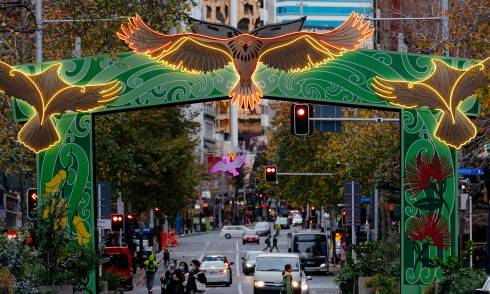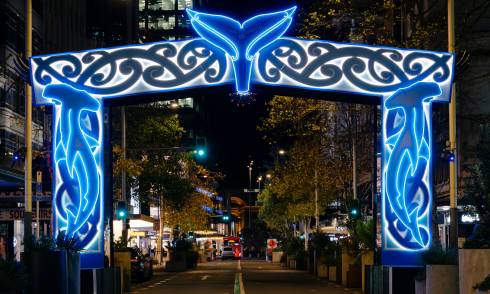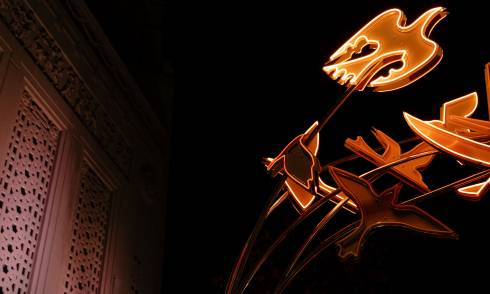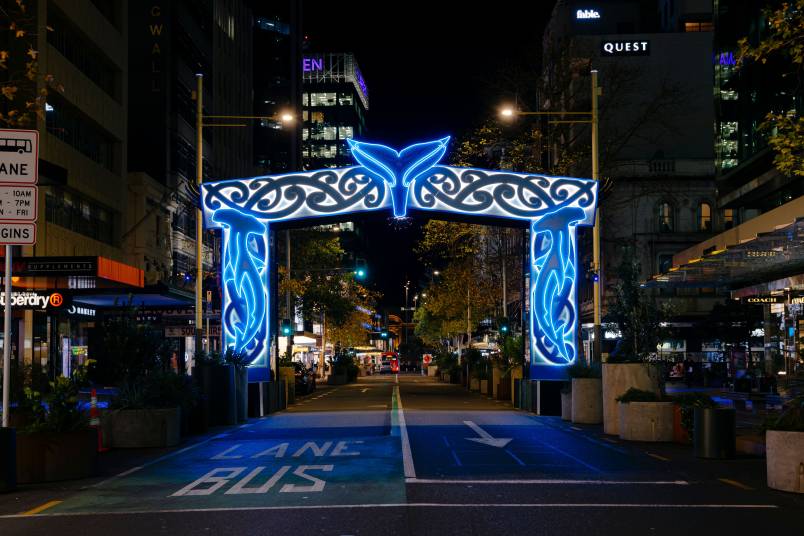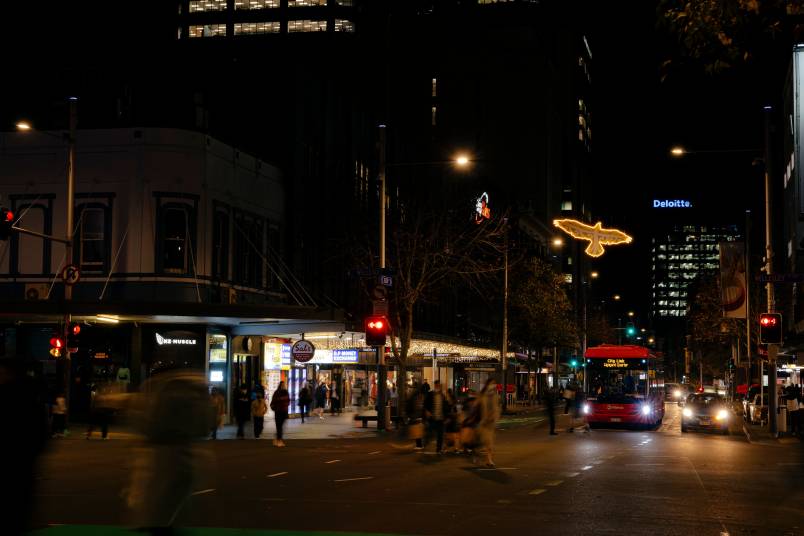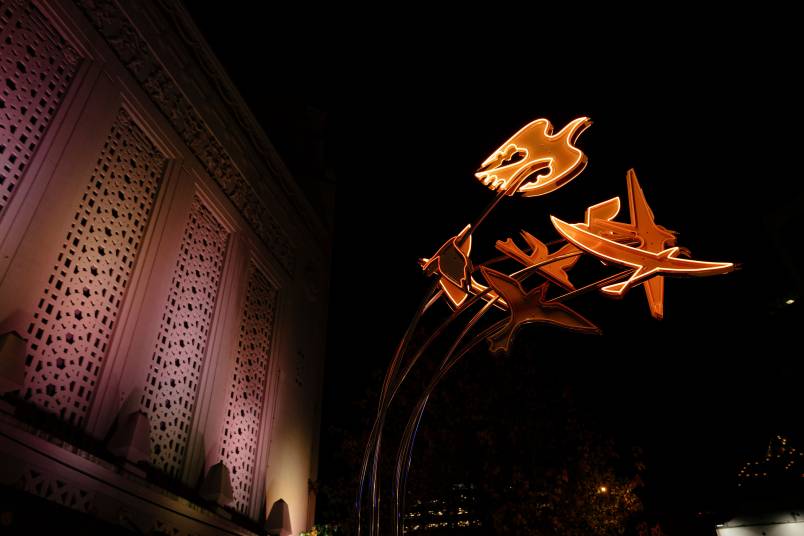From the karanga of Hape welcoming early waka voyagers, the open invitation from Ngāti Whātua Ōrākei to William Hobson to establish the settlement of Auckland in 1840, to becoming the beating heart of contemporary Tāmaki Makaurau, the Waihorotiu valley has always been a place renowned for the extension of manaakitanga, for welcoming and extending hospitality to visitors, to guests and to ourselves.
The ancient citadels Te Ngahuwera, Te Rerengaoraiti and Te Horo Roa standing above, the bountiful Wai o Horotiu river flowing along the valley floor to meet Te Waitematā, the abundant ngahere of the valley teeming with life and song, the generations upon generations of footprints left by Mana Whenua over the millenia; all part of a native and natural landscape now lost beneath the modern City Centre’s urban form, removed from our sight.
But not from our memories. Or our future.
Tūrama is an open invitation to all of Tāmaki Makaurau to revisit and re-imagine the Waihorotiu valley. You will be welcomed and farewelled by atua, dance on the sparkling waters of Te Waitematā and Waihorotiu, celebrate art works by icons of Māori art and design, meet the manu of this place, and come face to face with an 8 metre high representation of resident kaitiaki Horotiu.
Prepare to be amazed at the celebration of light, form, scale and life that has been developed for Tūrama by the creative team of Graham Tipene (Ngāti Whātua Ōrākei, Ngāti Kahu, Ngāti Hine, Ngāti Hauā, Ngāti Manu), Ataahua Papa (Ngāti Korokī Kahukura, Ngāti Mahuta) and Angus Muir Design.
The installations
Te Wehenga
Te Wehenga is a contemporary waharoa that has been located at this point to physically embody and mark this notion of transition, and to remind us of the native and natural ecologies of place – natural, social and cultural. This location at the junction of Shortland and Queen Streets marks a key point on the original coastline, where whenua (land) met moana (sea). It recognises two atua Māori, Tangaroa and Tāne Mahuta, tamariki of Papatūānuku and Ranginui the primordial parents. Artwork from Graham Tipene (Ngāti Whātua Ōrākei, Ngāti Kahu, Ngāti Hine, Ngāti Hauā, Ngāti Manu) powerfully invokes these atua and characteristics of their respective domains. Tāne Mahuta welcomes you into his domain as you head up Queen Street, and Tangaroa welcomes you into his realm as you head northwards towards Waitematā.
Kawau Tikitiki
The Kawau Tikitiki (cormorant/shag) is a significant manu (bird) for a number of iwi and hapū whose heartlands are located across the full breadth of Aotearoa. This bird is revered by ngāi Māori for its characteristics and character; its constancy of purpose, resolute nature, its tenacity, its slowness to move but speed in acting. For all of these attributes, the Kawau is often used in traditional oratory as metaphor for a Chief or a distinguished visitor.
Kāhu Kōrako
Kāhu Kōrako is a term for an older kāhu/hawk/New Zealand harrier (manu/bird) whose plumage has lost the dark colouring of youth and whose feathers are pale, white or grey. The plumage of Kāhu Kōrako is compared by Māori orators to the grey hair of elders. When coupled with the veneration that ngāi Māori hold for kuia, koroua and kaumātua, the term Kāhu Kōrako becomes a metaphor for an elderly person of mana. A person whose wisdom and grace will assist your passage wherever you travel within the hem of their korowai (cloak). In this context, Kāhu Kōrako is offered as a tribute and acknowledgement of Fred Graham (Ngāti Korokī Kahukura) ONZM, Art Foundation Icon. Two of his works are highlighted as part of Tūrama at the junction of Shortland and Queen Streets.
Manu Korokī
In days of old, as a place where life and the mauri (life force) of the environment abounded, the Waihorotiu valley and its meeting points with Te Waitematā (harbour) would have been home to multitudes of manu (birds) ngahere, manu wai māori and manu waitai. Manu are revered by ngāi Māori, and feature regularly as kaitiaki (guardians); the manifestation of tūpuna and as metaphor for the behaviours, attributes and character of individuals, groups, hapū and iwi. Manu Korokī is a collection of stylised forms of Tāmaki Makaurau birdlife in celebration of Matariki ki te Manawa and as a reminder of what once was.
Horotiu
He tupua, he taniwha, he kaitiaki
Wai o Horotiu is the ancestral river that once flowed through what is now the Queen Street valley. The river sustained and enabled settlement of this area over the millenia, and the valley is literally thick with ngā tapuwae o ngā mana o te whenua (the footprints of local tribes), embedded into this space over time, testament to the richness of local resources and strategic importance of this location.
Alongside these tūpuna (ancestors), this valley and its river were also the domain of Horotiu, a being of both physical and metaphysical dimensions. Horotiu is recognised variously by Mana Whenua as kaitiaki of this area, and also as taniwha (fabulous monster) within this, his domain; an enduring influence to remind us, and to challenge us.
Despite the historic covering over and containment of Wai o Horotiu, this river still flows and dances beneath our feet, and retains both mana and mauri, albeit compromised significantly by our contemporary urban form and lifestyles.
For Ngāti Whātua Ōrākei, having Horotiu stand in this place in this way is a powerful and poignant challenge to us all to consider the health and wellbeing of our urban waterways and water systems, as plans for the development of Tāmaki Makaurau continue. Continuing to tell the many stories of this place, broadening understanding and ensuring the education of the many generations ahead of us who will inhabit the legacies we are creating through our actions remain ongoing and important challenges for us all.
The whenua now occupied by the Auckland Town Hall was once a kāinga (settlement site). Development of this space uncovered koiwi (human remains). The resting place of these tūpuna was disrupted, requiring them to be uplifted and reinterred elsewhere to enable construction. Horotiu sits in Aotea Square and prompts us to remember the sacrifice of those who have shaped this place for all Aucklanders and whose memory we should acknowledge into the future.
Horotiu is a collaboration between Graham Tipene (Ngāti Whātua Ōrākei, Ngāti Kahu, Ngāti Hine, Ngāti Haua, Ngāti Manu), Ataahua Papa (Ngāti Korokī Kahukura, Ngāti Mahuta) and Angus Muir Design.
Supported by mana whenua Ngāti Whātua Ōrākei and Te Kaunihera o Tāmaki Makaurau / Auckland Council.
Get $2.50 parking per hour to a maximum of $15.50 on evenings and weekends at the Downtown car park. Find out more.
Kids ride free on public transport on weekends and public holidays. Find out more.
